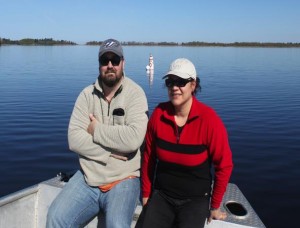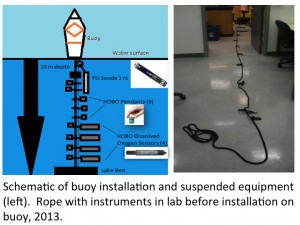June – October 2013
Research Team: Jamie Lavigne, MESc. Student, Dan Walters, April James, Krys Chutko (faculty, Dept. of Geography, Nipissing University).
The input of excess nutrients to our waterways is one of the many variables that contribute to the increasing occurrence of blue green algae. In Callander Bay, Ontario, this not only poses health threats (Callander Bay is the municipal water source) but also negatively impacts local tourism and recreational use of the Bay.
One gap in understanding of the inputs of nutrients to the bay is the question of how much comes from internal loading, where nutrients like phosphorus can be released from sediments back into the water column under low oxygen conditions.
During the summer of 2013, our team installed a buoy and instrumentation to monitoring the thermal stratification patterns in the Bay. The buoy was donated by the Dorset Environmental Science Centre (Ontario Ministry of Environment) and was installed with the help of our local Ministry of Natural Resources office.
Jamie Lavigne, Dept. of Geography took on this project for her MESc thesis, regularly checking on temperature, light and dissolved oxygen sensors hung in the water column below the buoy and performing spot sampling at 5 additional locations around the Bay.
In this first year of the project, data was collected from June to end of October 2013. We will examine the data this winter and the buoy will be redeployed in spring 2014 for a second season.



